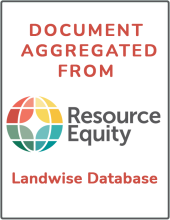Land Library
Bem-vindo à Biblioteca do Land Portal. Explore nossa vasta coleção de recursos de acesso aberto (mais de 74.000), incluindo relatórios, artigos de revistas científicas, trabalhos de pesquisa, publicações revisadas por pares, documentos jurídicos, vídeos e muito mais.
/ library resources
Showing items 1 through 9 of 156.This first annual trends and outlook (ATOR) report for Swaziland assesses the performance of the agriculture sector in terms of investment, growth, and poverty and hunger outcomes over the period 2000–2011.
This report presents results of the 2012 Annual Trends and Outlook for Malawi (ATOR). This is the first ATOR for Malawi.
Zambia recognizes two types of land tenure: customary and leasehold tenure. While historically the majority of land in Zambia has been held under customary tenure, leases (also called leasehold titles) are the only legal means of holding land rights.
Mozambique is the 8th most vulnerable country to climate change and is one of the poorest countries in the world with a high dependency on foreign aid. The population is primarily rural and dependent on agriculture, with 60% living on the coastline.
This paper, which focuses on the Chinyanja Triangle (CT), an area inside the Zambezi River Basin, characterises three distinct farming subsystems across rainfall gradients, namely maize-beans-fish, sorghum-millet-livestock and the livestock-dominated subsystem.
Land has historically been a source of dispute and conflict in Rwanda, compounded by the social unrest which resulted in the 1994 genocide.
During the 1990s, powerful development institutions like the World Bank came to see the social networks and norms of the rural poor in developing countries as 'assets' to be tapped for poverty alleviation.
Mozambique has experienced accelerated rates of growth over the past decade, averaging 7.2% per year, with projected growth rates of over 8%.




